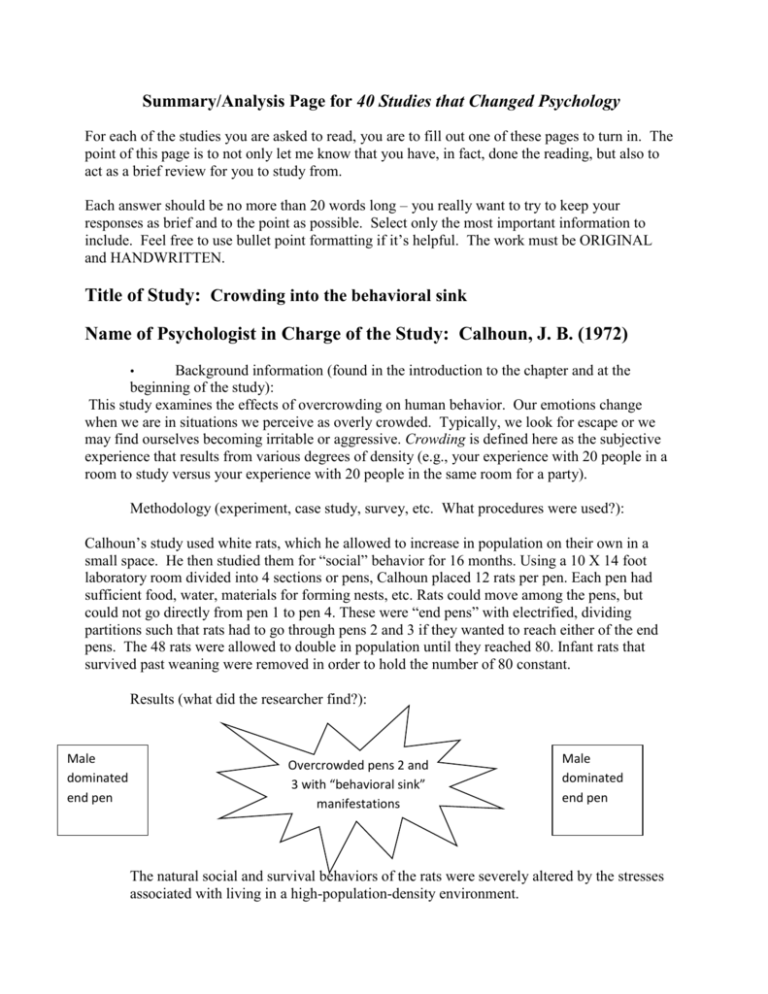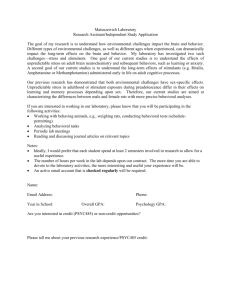AP Psychology Summary Analysis Sheet Crowding into Behavioral
advertisement

Summary/Analysis Page for 40 Studies that Changed Psychology For each of the studies you are asked to read, you are to fill out one of these pages to turn in. The point of this page is to not only let me know that you have, in fact, done the reading, but also to act as a brief review for you to study from. Each answer should be no more than 20 words long – you really want to try to keep your responses as brief and to the point as possible. Select only the most important information to include. Feel free to use bullet point formatting if it’s helpful. The work must be ORIGINAL and HANDWRITTEN. Title of Study: Crowding into the behavioral sink Name of Psychologist in Charge of the Study: Calhoun, J. B. (1972) • Background information (found in the introduction to the chapter and at the beginning of the study): This study examines the effects of overcrowding on human behavior. Our emotions change when we are in situations we perceive as overly crowded. Typically, we look for escape or we may find ourselves becoming irritable or aggressive. Crowding is defined here as the subjective experience that results from various degrees of density (e.g., your experience with 20 people in a room to study versus your experience with 20 people in the same room for a party). Methodology (experiment, case study, survey, etc. What procedures were used?): Calhoun’s study used white rats, which he allowed to increase in population on their own in a small space. He then studied them for “social” behavior for 16 months. Using a 10 X 14 foot laboratory room divided into 4 sections or pens, Calhoun placed 12 rats per pen. Each pen had sufficient food, water, materials for forming nests, etc. Rats could move among the pens, but could not go directly from pen 1 to pen 4. These were “end pens” with electrified, dividing partitions such that rats had to go through pens 2 and 3 if they wanted to reach either of the end pens. The 48 rats were allowed to double in population until they reached 80. Infant rats that survived past weaning were removed in order to hold the number of 80 constant. Results (what did the researcher find?): Male dominated end pen Overcrowded pens 2 and 3 with “behavioral sink” manifestations Male dominated end pen The natural social and survival behaviors of the rats were severely altered by the stresses associated with living in a high-population-density environment. Discussion (what do these results mean?): For the rats in the experiment—Although 20 rats could be easily accommodated in each of the four pens, rats did not spread out in this pattern. Fights for social status and dominance among males occurred in the end pens (one way out) and resulted in one male with several females housed there. In the middle pens, 60 or so rats crowded there and a host of what Calhoun called “behavioral sink” behaviors resulted. These included: aggression, submissiveness (among otherwise characteristically aggressive males; countered by probers who also became cannibalistic), sexual deviance (defined by failing to follow the established mating rituals and pursuing females at will), and reproductive abnormalities (defined as females failing to adequately build nests for the coming young and to transport them properly from place to place). Infant mortality in the middle pens was extremely high. For humans—Calhoun was careful not to make any logical extensions to humans based on his findings. The results, though, do speak for themselves. Critique (strengths and weaknesses of study): Criticism regarding methodology—real-life crowded situations usually exist over extended periods of time (cities such as Manhattan and Mexico City, housing projects, prisons, etc.) and there are many factors other than population density that may influence a person’s behavior in these settings. Relevance/Recent Applications: (1) Relevance for design of institutions such as prisons. Again, other factors may influence behaviors in such places as prisons. See Zimbardo’s prison study. (2) Relevance for institutions such as schools as experiments have shown that crowding produces negative effects on problem solving abilities. (3) Individually, humans have demonstrated that blood pressure and heart rate increases in crowded settings. We tend to feel that other people are more hostile and that time seems to pass more slowly as density increases. (4) Questionable relevance for suggesting that density (in homes or cities) contributes directly to psychological pathology (e.g., studies performed to link the manifestation of schizophrenia and/or bi-polar disorder to crowded conditions were not conclusive). Ethical issues (discuss any issues that might have been involved or that were avoided): (1) Ethically impossible to place humans in a crowded setting for long periods of time simply to do research on them. Calhoun’s study used white rats, which he allowed to increase in population on their own in a small space. Note: in a much earlier study using 150 rats in a protected open space, Calhoun observed adverse maternal and reproductive behaviors among rats as even the protected situation produced extreme behavioral changes. (2) Ethically, it is risky to apply results of animal studies to humans; at its best, animal research can lead the way to more studies for humans. Relevant gender/cross-cultural differences/issues (were gender/cross-cultural issues or differences addressed? Should they be?): Your turn How does this study relate to the chapter we’re covering in class, or even previous chapters? Use appropriate terminology when relevant: Your turn Personal Discussion/Connection (write about your questions, anything interesting you learned, issues the reading make you think of, such as connections with your life, current events, etc.)(This answer can be longer than 20 words): Your turn Mnemonic device/cartoon to help you remember the researcher/topic of study: Just a bit more, please! Calhoun’s “pens” See also additional readings






